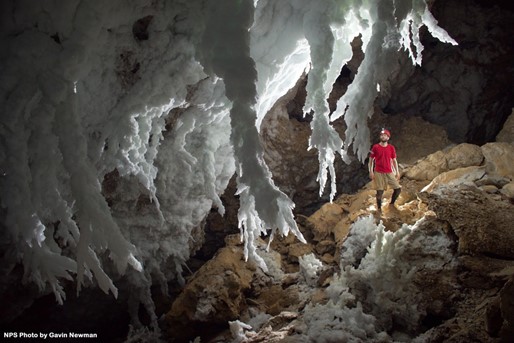
Credit: NPS photo by Gavin Newman, public domain
Carlsbad Caverns National Park is a very rare place.
Its main room is the largest cave chamber in North America, covering more than eight acres. And its cave formations are unsurpassed anywhere.
It’s also rare because it was created not by carbonic acid percolating down through the soil but by sulfuric acid coming up from below.
Around 20 million years ago, hydrogen sulfide gas began to migrate underground from oil deposits in the Permian Basin of Texas, toward the exposed fossilized reefs near what is now Carlsbad, New Mexico.
There, the hydrogen sulfide gas rose to meet the water table. It combined with oxygen to create sulfuric acid and began to dissolve the limestone that forms the Permian reef.
Over the ages, as the water table rose and fell, the sulfuric acid worked on shallower and deeper layers, creating hundreds of caverns, some thousands of feet below ground.
Around a million years ago, erosion connected the caves to the surface. Mineral-enriched water began to trickle in and, drop by drop, over millennia, formed spectacular crystal formations of calcite, aragonite, and gypsum.
Seven thousand five hundred years ago the area began to dry up and the cave formations stopped growing.
But they’re preserved there today in all their glory—waiting for you to make the trip to Carlsbad Caverns, to see some of the most stunning geology in the world.
Background
Synopsis: The first official survey of Carlsbad Cave was completed 100 years ago on May 8, 1923. The cave is the centerpiece of New Mexico’s Carlsbad Caverns National Park, where at least 120 remarkable caves have been found so far. These caverns formed four to six million years ago as hydrogen sulfide gas migrated upward from nearby petroleum deposits into the 265-million-year-old Permian reef limestones. The caves are uniquely ornamented with intricate calcium carbonate (calcite) and calcium sulfate (gypsum) mineralization.
- Carlsbad Caverns are a collection of around 120 caves within the area of Carlsbad Caverns National Park, in America’s Chihuahuan Desert.
- The caves occur within limestones and dolomites of the Guadalupian (259- to 277-million-year-old) reef system that rimmed the Permian Delaware Basin.
- The reef was exhumed in the past 20 million years to become exposed in the Guadalupe Mountains of Texas and New Mexico.
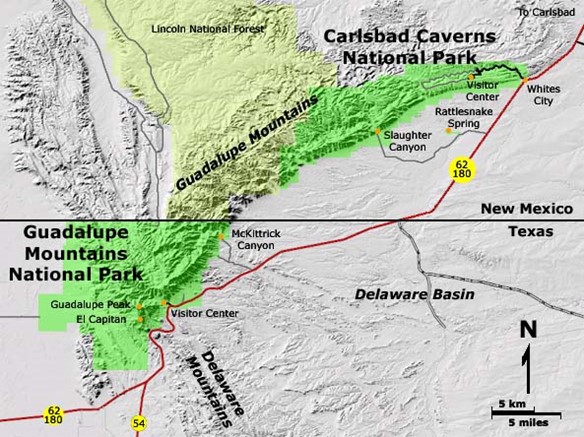
Regional map along the Texas–New Mexico border showing area roads, nearby towns, Guadalupe Mountains National Park, and Carlsbad Caverns National Park.
Credit: USGS - The number of caves continues to increase as new caves are discovered, however, not all extend to the surface and those may never be found.
- The focal point of the cavern systems is Carlsbad Cavern, first documented by Jim White during explorations from 1898 to 1903.
- Pictographs in the cave entrance indicate a long history of Indigenous visitation for thousands of years prior to White’s explorations.
- Guano mining for fertilizer began at the “Bat Cave” in 1903.
- Ray Davis photographed the cave from 1915 to 1928, increasing awareness.
- From April 6 to May 8 of 1923, a hundred years ago, Robert Holley of the General Land Office mapped and surveyed the cave.
- Holley recommended it be considered for National Monument status, and on October 25, 1923, Calvin Coolidge created “Carlsbad Cave National Monument.”
- In May of 1930, Congress enlarged the area, designating it “Carlsbad Caverns National Park” as additional caverns were discovered.
- Since 1924, the park has hosted more than 44 million visitors, about 500,000 each year.
- Carlsbad Caverns was designated a World Heritage Site in 1995.
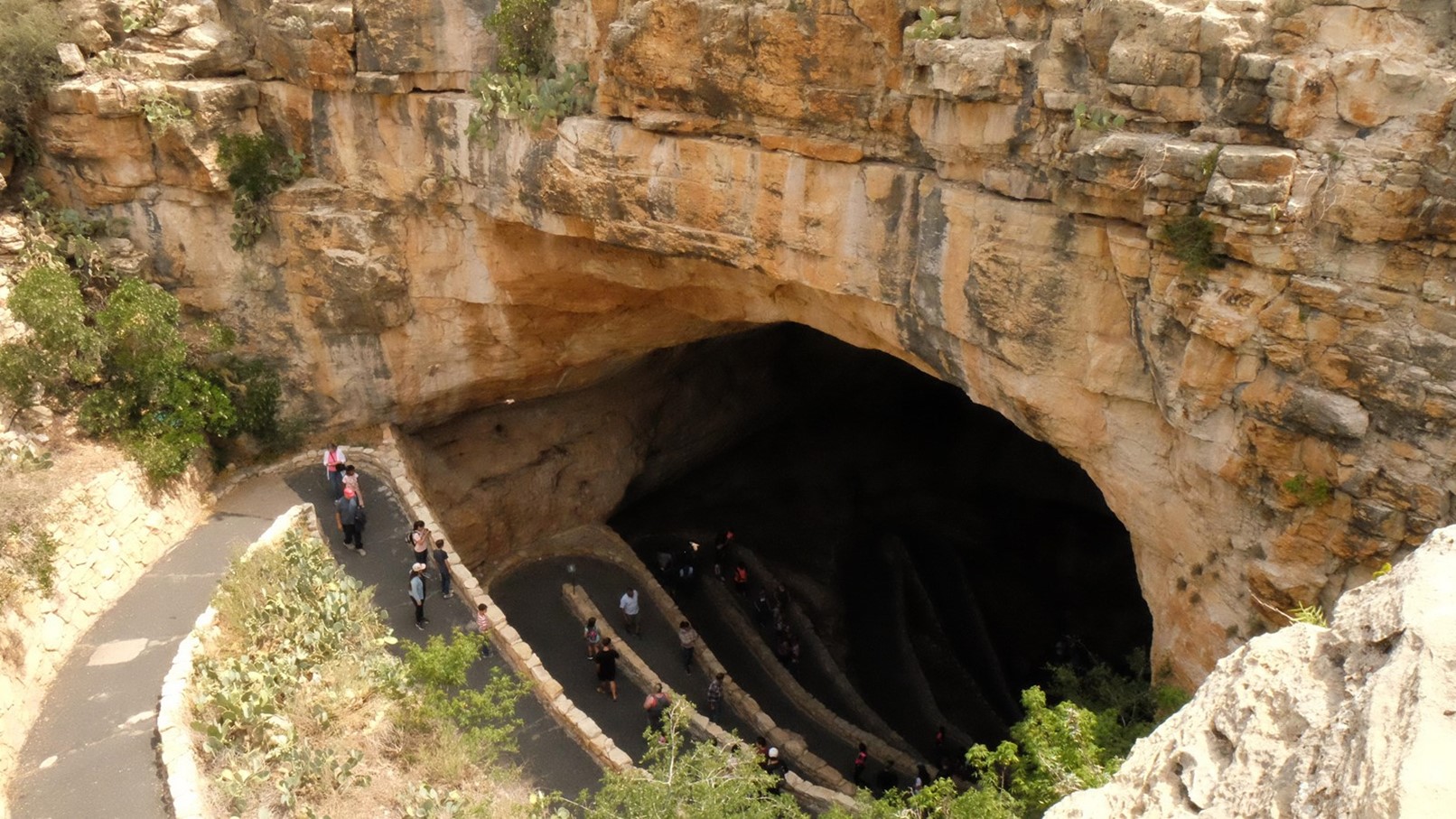
The natural entrance into Carlsbad Cave starts the 1.25 mile (2 kilometer) trail descending 754 feet (230 meters) into the Big Room. Elevators to the same destination were installed in 1932 and 1955.
Credit: NPS Eymard Bangcoro
- Over 40 mi (64 km) of passages have been mapped in Carlsbad Cavern, which is open to the public year-round.
- The first elevator began operation in 1932. A larger capacity elevator was installed in 1955 to carry passengers 754 ft (230 m) down into the cave.
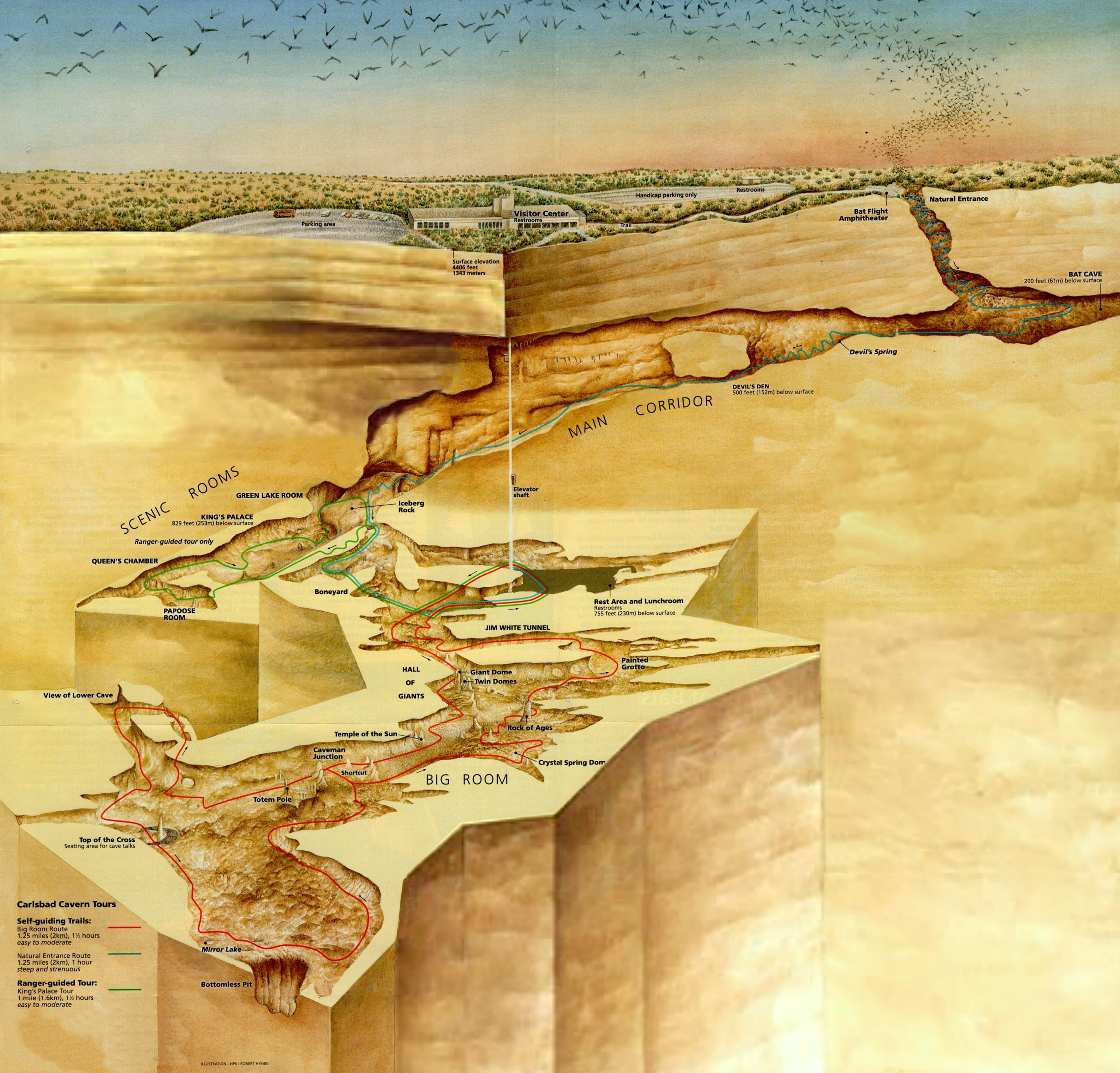
Three-dimensional representation of Carlsbad Cave.
Credit: Robert Hynes/US National Park Service, public domain, via Wikimedia Commons - Carlsbad’s Big Room is North America’s largest single cave chamber by volume, covering 8.2 acres (more than six football fields). It is 4,000 ft (1,220 m) long, 625 ft (191 m) wide, and up to 255 ft (78 m) high and includes a 1.25 mi (2 km) trail.
- The cavern extends 1,035 ft (315 m) below ground into the 265-million-year-old Capitan Limestone characterized by ancient Guadalupian reefs.
- The first elevator began operation in 1932. A larger capacity elevator was installed in 1955 to carry passengers 754 ft (230 m) down into the cave.
- In May of 1986, cavers broke through a rubble filled pit at the entrance to discover the spectacular Lechuguilla Cave and have now mapped more than 150 mi (242 km) of passages.
- Its entrance is in the ridge to the west–northwest of the Carlsbad Cave entrance and across Walnut Canyon, but these two large caves do not connect.
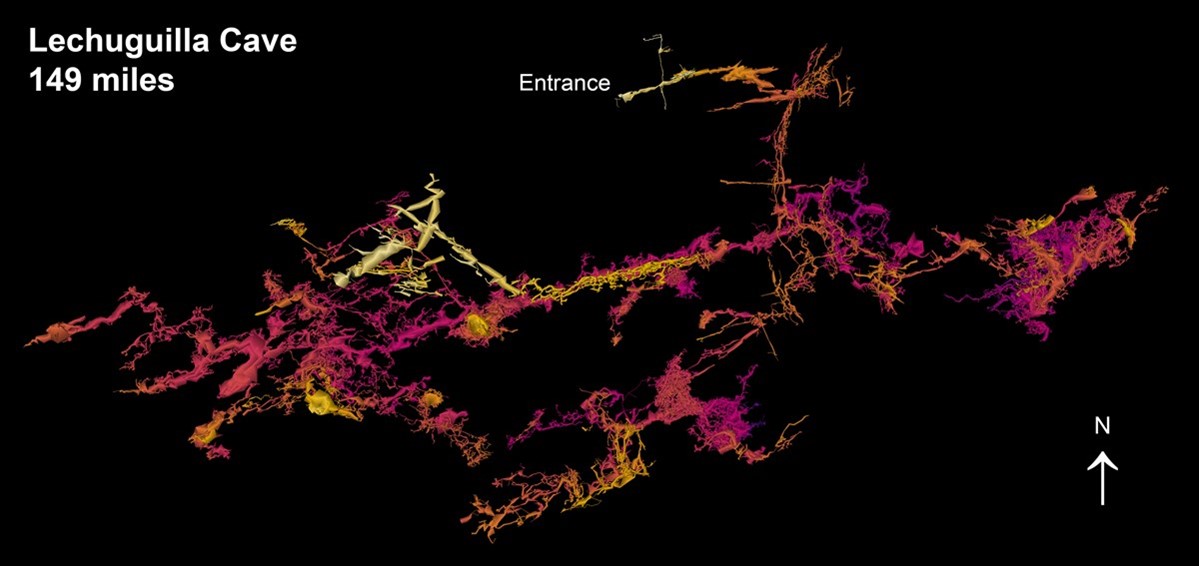
In this July 2019 3D map of Lechuguilla Cave, lighter colors show shallower elevations. It is the second deepest cave in North America, extending to more than 1,600 feet (488 meters).
Credit: NPS - Lechuguilla Cave extends through the Capitan Limestone into a slightly older Guadalupian fossil reef known as the Goat Seep Dolomite.
- Access to this cave system is limited to research and exploration, it is not open to the public in the interest of preserving its delicate speleothems (cave deposits) and its rare ecosystems. Bacteria found only in Lechuguilla Cave have provided promising leads in the search for cancer-fighting drugs.
- Other well-known caves in the park include Slaughter Canyon Cave and Spider Cave, the former of which can be accessed by guided adventure tours.
- Its entrance is in the ridge to the west–northwest of the Carlsbad Cave entrance and across Walnut Canyon, but these two large caves do not connect.
- The fragile speleothems of Carlsbad Caverns are different from most cave systems.
- Most caves are solution caves, forming from carbonic acids derived from carbon dioxide enriched water percolating into reactive carbonate rocks, like limestones and dolomites (ED-067 Amazing Caves).
- Less than 5% of caves form from rock interactions with hydrogen sulfide (H2S) that produce sulfuric acid (H2SO4), which dissolves carbonate host rock, leaving behind sulfate minerals like gypsum (CaSO4·2H2O) that form delicate structures.
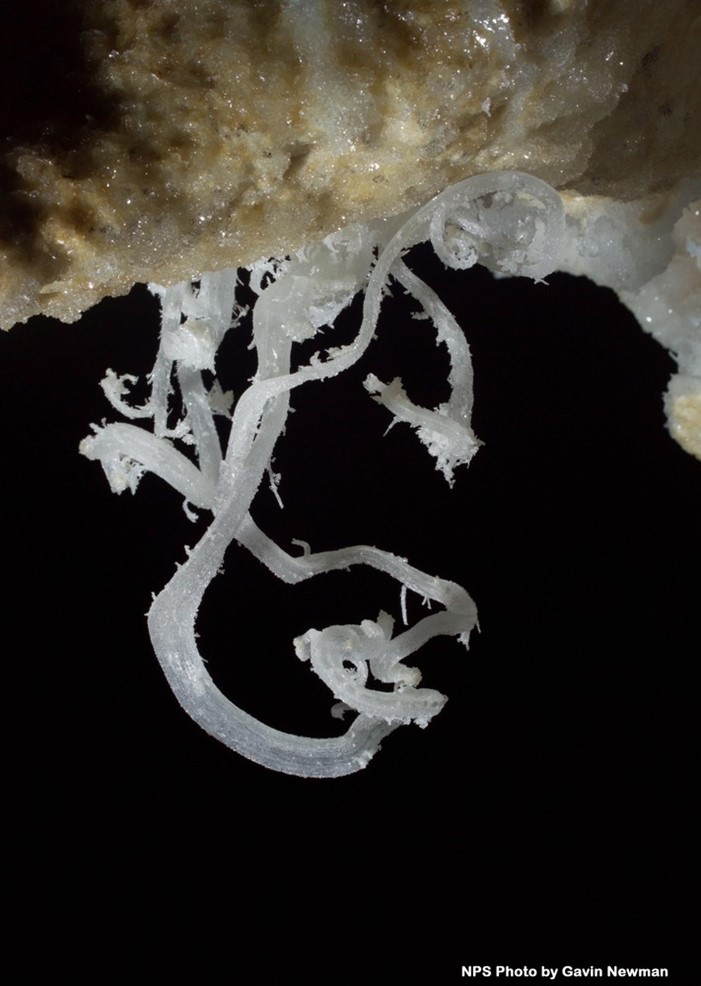
A gypsum flower from Lechuguilla Cave in Carlsbad Caverns National Park, New Mexico. These speleothems form in drier cave conditions, growing from the base and bending in response to varying flow rates.
Credit: NPS Gavin Newman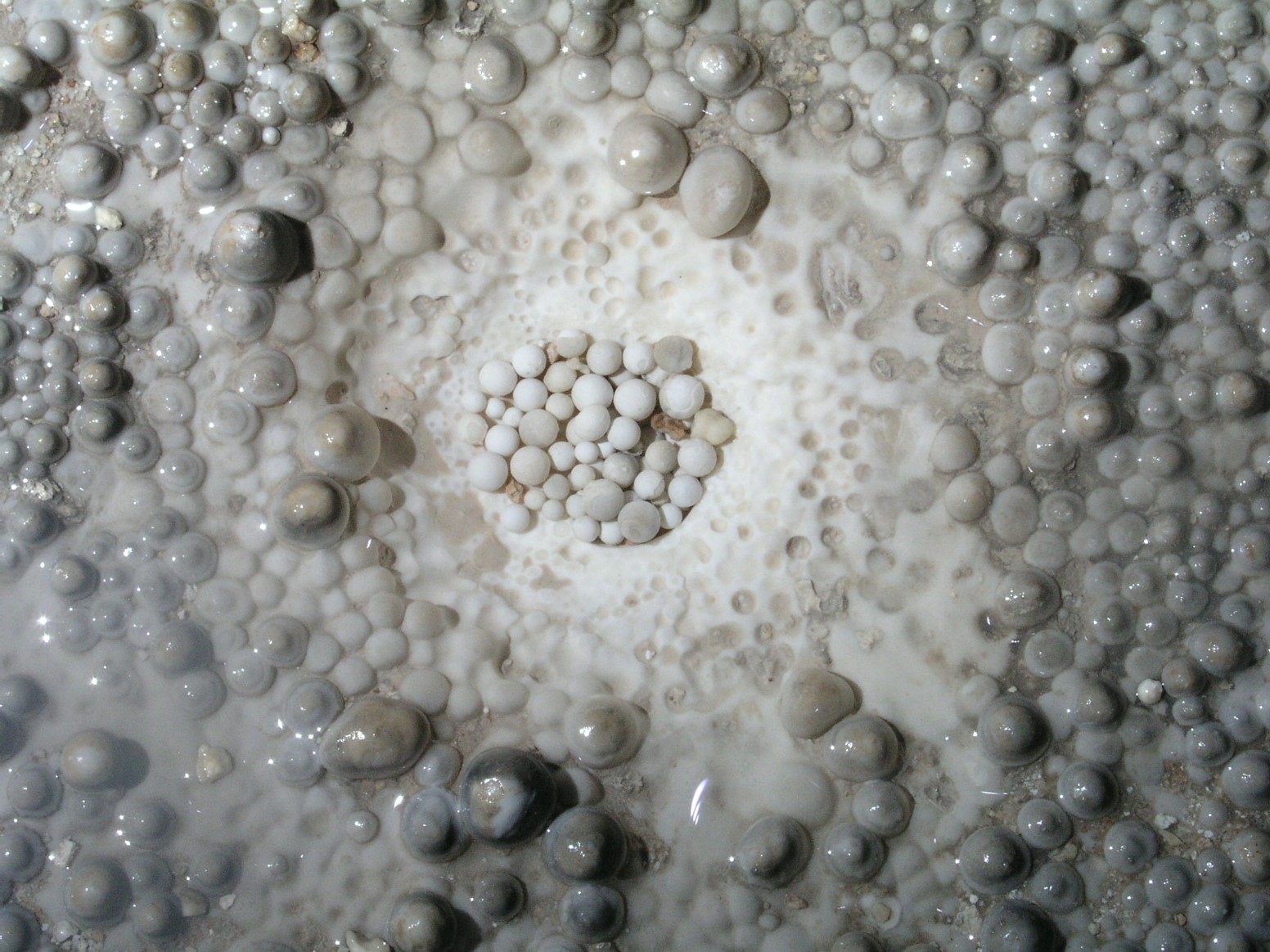
Cave pearls form a typical nest in the Rookery portion of the Lower Cave in Carlsbad Cavern. These are spherical speleothems that grow as concentric layers forming around a nucleus rotated continuously by dripping water.
Credit: WTucker at the English Wikipedia, via Wikimedia Commons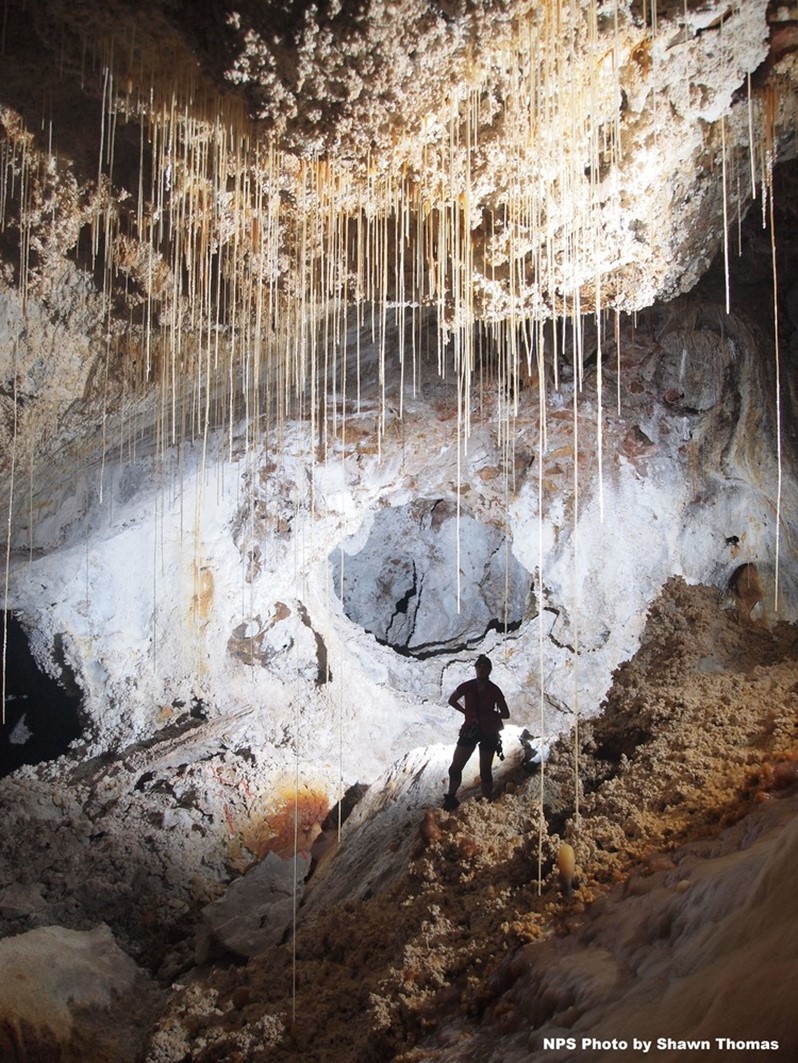
Soda Straws are hollow tubes that grow very slowly as mineral rich water leaches through the roofs of caves to drip from their ends. If blocked, they may turn into stalactites if water starts flowing on the outside of the tube.
Credit: NPS Shawn Thomas
- The beautiful speleothem displays in Carlsbad’s caves are unsurpassed globally and owe their existence to the unique geological history of the region.
- The reefs formed around a deep equatorial embayment on the hot, dry western edge of Pangea during the Permian Period, around 265 million years ago.
- The sheer cliff of El Capitan in Guadalupe Mountains National Park exposes sponges, algae, and natural cement, which were the main constituents of the core of the 400-mile-long reef system that grew to more than 750 ft (230 m) tall.
- As the sea retreated, evaporite deposits formed, then the basin filled with sediments.
- Basin and range block faulting started around 20 million years ago and continued through the Miocene and Pliocene Epochs, uplifting the region.
- Erosion exhumed the ancient reef system, removing up to 10,000 ft (3,050 m) of sediments. The resistant reef was now the Guadalupe Mountains.
- At around the same time, microbial activity and hydrocarbon migration in the Permian Basin caused hydrogen sulfide (H2S) gas to move toward the fossilized reefs along the basin margin.
- At the water table, H2S combined with oxygen to produce aggressive sulfuric acid that dissolved the carbonates to create large caves. As the paleo water table changed levels over millennia, different levels in the caves were formed. This happened several times.
- The intricate decorations formed in the last million years or so when the caves opened to the surface, allowing the inflow of air and surface water that slowly created delicate crystal structures made of calcite, aragonite, and gypsum, drop by drop or molecule by molecule.
- With today’s desert climate in the region, most of the Carlsbad Cavern’s speleothems are no longer growing, but it is amazing to think that this delicate crystal garden is preserved below the arid surface of the National Park. The desertification of the region began 7,500 years ago.

